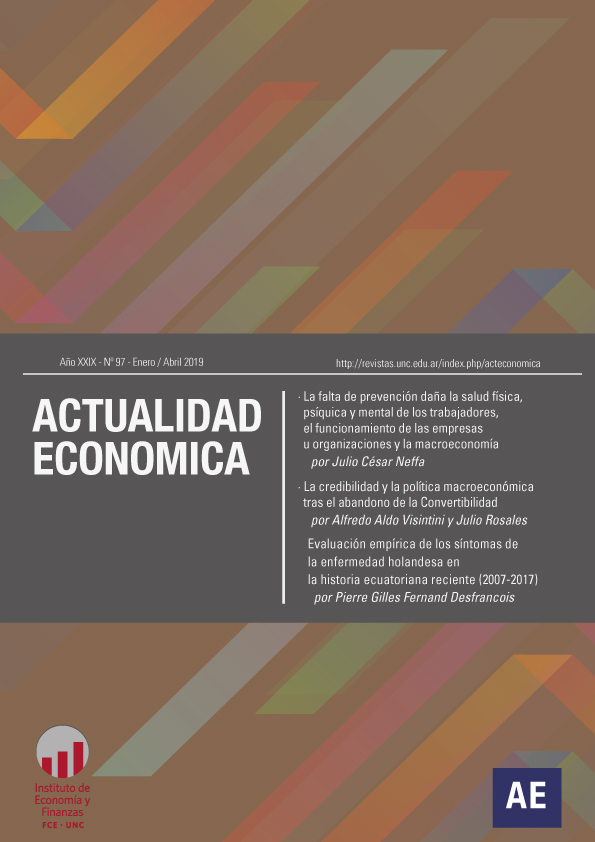The Credibility and the Macroeconomic Policy after the abandonment of Convertibility
Keywords:
Macroeconomic Policy, Stabilization Policy, Fiscal and Monetary Policy Analysis, Economic Policy Episodes, Economic HistoryAbstract
This paper describes and analyzes the macroeconomic policy, in particular the monetary and exchange policy, adopted since the abandonment of the Convertibility in 2002 by the Government of E. Duhalde from considering the concept of credibility. The analysis concluded that: 1) the announcements and macroeconomic policy measures taken to deal with the crisis were implemented in a context of total loss of credibility of the authorities after the abandonment of the Convertibility, 2) the response of the In the face of such a loss of credibility, the government took fiscal and monetary adjustments to extremes in order to contain the exchange volatility and reverse the expectations of hyperinflation with a huge cost in terms of falling output, increased unemployment and poverty, and 3) the reversion of the expectations of the economic agents, which manifested itself in the containment of the volatility of the exchange rate, shows that the strong fiscal and monetary adjustment had a much greater weight than the reputational factors in the formation of the expectations
Downloads
References
Amano, R., Fenton, P., Tessier, D. y Norden, S. (2000). “The credibility of monetary policy: A survey of the literature with some simple applications to Canada”. Bank of Canada.
Banco Central de la República Argentina (2003). “Boletín Monetario y Financiero – Edición Anual 2002”. Buenos Aires, Argentina
Banco Central de la República Argentina (2002). “Programa Monetario” versiones Febrero y Junio 2002.
Baxter, M. (1985). “The role of expectations in stabilization policy”. Journal of Monetary Economics, vol 15.
Becker, V. y Escudé (2007). “Vida, pasión y muerte de la convertibilidad en Argentina”. Anales de la Asociación Argentina de Economía Política, Bahía Blanca
Calvo, G. y Reinhart, C. (1999). “Capital Flow Reversals, the Exchange Rate Debate, and Dollarization” IMF Finance and Development Vol. 36, N° 3.
Caldas Montes, G. (2009). "Reputation, credibility and monetary policy effectiveness". Estudos Econômicos (São Paulo), v. 39, n. 3, p. 673-698.
Cukierman, A. (1986). “Central Bank Behavior and Credibility: Some Recent Theoretical Developments”. Federal Reserve Bank of St. Louis, USA.
Da Silveira, Jair y Tadeu Lima, Gilberto (2015). “Conquering credibility for Monetary Policy under sticky confidence”. Revista Brasileira de Economia v. 69 n. 2 / p. 251–261. Río de Janeiro, Brasil
Drazer, A. y Masson, P. (1993). “Credibility of policies versus credibility of policymakers” NBER Working Paper N° 4448, Cambridge, USA.
De Gregorio, J. (2007). Macroeconomía: Teoría y Política. Ed. Pearson education, Santiago de Chile.
De Pablo, J. C. (2012). “Política Económica y toma de decisiones” Serie Documentos de Trabajo N° 492, UCEMA, Buenos Aires.
Levi Yeyati, E. (2001). “10 años de Convertibilidad: la experiencia argentina”. Revista de Análisis Económico volumen 16, N°2, Universidad Alberto Hurtado, Santiago de Chile.
Laurens, B. y de La Piedra, E. (1998). “Coordination of Monetary and Fiscal Policies” International Monetary Fund, Working Paper 98/25
Perrier, P. y Amano, R. (2000). “Credibility and monetary policy” Bank of Canada Review. vol. 2000, spring.
Remes Lenicov, J. Todesca, J. y Ratti, E. (2003). “La política económica de principios de 2002: cambios profundos para superar la crisis provocada por el colapso de la convertibilidad y sentar las bases para el funcionamiento de una economía normal, integrada al mundo”. Buenos Aires.
Rodriguez, C. A. (2001). “Carta a los que proponen la dolarización”. CEMA, Buenos Aires. Disponible en: https://www.ucema.edu.ar/u/car/Dolarizacion.pdf
Downloads
Published
Issue
Section
License
Those authors who have published with this journal, accept the following terms:
Authors will conserve their copyright and guarantee the magazine the right of first publication of their work, which will be simultaneously subject to the Creative Commons Attribution-NonCommercial-NoDerivative 4.0 International License that allows third parties to share the work as long as the author and first publication of this magazine are indicated.
Authors may adopt other non-exclusive license agreements to distribute the published version of the work (e.g., deposit it in an institutional telematic archive or publish it in a monographic volume) provided that the initial publication in this journal is indicated.
Authors are allowed and encouraged to disseminate their work through the Internet (e.g., in institutional telematic archives or on their website) before and during the submission process, which may lead to interesting exchanges and increase citations of the published work. (See The effect of open access)









